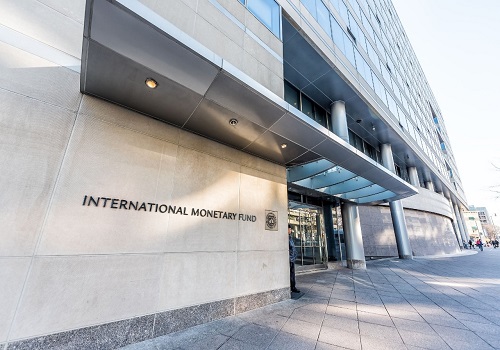Gold trading range for the day is 57395-58345 - Kedia Advisory

Follow us Now on Telegram ! Get daily 10 - 12 important updates on Business, Finance and Investment. Join our Telegram Channel
Gold
Gold saw a 0.54% increase, closing at 57,940, driven by heightened safe-haven demand due to concerns about the Israel-Hamas conflict potentially escalating. Additionally, the expectation of the Federal Reserve maintaining a pause on interest rate hikes was a positive factor for the precious metal. However, there was a noteworthy development with fresh Producer Price Index (PPI) figures indicating a higher-than-expected rise in US producer prices, particularly in the energy sector, signaling current inflationary risks. All eyes are now on the central bank's meeting minutes and upcoming US inflation data. Federal Reserve officials, including Vice Chair Philip Jefferson and Dallas Fed President Lorie Logan, emphasized the need for caution given recent yield increases. Currently, the market suggests an 86% likelihood that the Fed will keep rates unchanged next month, according to the CME FedWatch Tool. On the physical gold front, there was an increase in demand in some Asian markets, triggered by a drop in gold prices that attracted buyers. India, in particular, saw premiums reaching a 17-month high as jewellers stocked up in preparation for the festival season, allowing them to charge higher premiums. From a technical perspective, the market experienced short covering, with a -3.95% drop in open interest, settling at 14,208 contracts. Gold's price increased by 311 rupees. Support is currently at 57,665, with the potential to test 57,395, while resistance is expected at 58,140, with a potential move to 58,345.
Trading Ideas:
* Gold trading range for the day is 57395-58345.
* Gold prices higher on more safe-haven demand amid the Israel-Hamas war that could well escalate
* Notions of continued pause in Federal Reserve interest rate increases are also a bullish element.
* Fresh PPI figures showed a higher-than-expected rise in the US producer prices
Silver
Silver registered a 0.74% increase, closing at 69,426, as investors continued to assess the monetary policy outlook amidst recent economic data and Federal Reserve remarks. Dovish signals from the Fed and lower Treasury yields, due to the Middle East conflict, bolstered the metal's appeal as a safe haven. Strong US jobs data raised expectations of another Fed rate hike before year-end, keeping interest rates high and affecting silver's appeal as investors turned to fixed income. Nevertheless, hopes for China's economic recovery, limited supply, and advancements in solar panel technologies with higher conductivity requirements supported silver prices. The International Monetary Fund (IMF) maintained its 2023 global economic growth forecast at 3% but reduced the 2024 projection to 2.9%. The IMF cited various reasons for downgraded forecasts for multiple economies, both new and long-standing issues. While economic activity improved significantly this year, global growth remains lower than pre-pandemic levels, especially in developing economies. From a technical perspective, the market saw short covering, with a -3.99% drop in open interest, settling at 25,559 contracts. Silver's price increased by 508 rupees. Support is currently at 69,020, with the potential to test 68,610, while resistance is expected at 69,795, with potential movement to 70,160.
Trading Ideas:
* Silver trading range for the day is 68610-70160.
* Silver gains as investors continued to gauge the monetary policy outlook following the latest economic data
* The metal was supported by dovish signals from the US Federal Reserve and lower Treasury yields
* The hot US jobs data strengthened beliefs that the Fed might be in for another hike before the end of the year
Crude oil
Crude oil experienced a -2.01% drop, closing at 7,017, as concerns about potential supply disruptions in the Middle East due to the Israel-Hamas conflict began to fade. Saudi Arabia expressed support for OPEC+ efforts to stabilize oil markets and promote global growth. Iran denied involvement in Hamas' actions against Israel, and the White House found no evidence of Iranian planning or direction. Furthermore, the US and Venezuela made progress in talks that could ease sanctions on Caracas, potentially allowing one additional foreign oil company to purchase Venezuelan crude oil under certain conditions. Notably, the OPEC forecasted Middle East oil demand to grow to 11.9 million barrels per day (mbpd) in 2045, an increase of 3.6 million bpd compared to 2022. This contrasts with the oil demand outlook in OECD countries, where demand is expected to fall by 9.3 million bpd over the same period. Between 2022 and 2045, the road transportation, petrochemical, and aviation sectors are predicted to drive the most significant global demand increase, by 4.6 million bpd, 4.3 million bpd, and 4.1 million bpd, respectively. From a technical perspective, the market saw fresh selling with a 3.71% increase in open interest, settling at 9,200 contracts. Crude oil's price declined by -144 rupees. Support is currently at 6,896, with the potential to test 6,776, while resistance is expected at 7,172, with potential movement to 7,328.
Trading Ideas:
* Crudeoil trading range for the day is 6776-7328.
* Crude oil fell as fears of possible supply disruptions in the Middle East started to fade.
* Saudi Arabia reiterated its support for efforts by OPEC+ to balance oil markets and measures that could bolster global growth.
* OPEC raises estimates for future oil demand in Middle East
Natural gas
Natural gas fell by -1.07% to close at 277.8, mainly due to milder weather forecasts, which project lower demand over the next two weeks. The International Energy Agency (IEA) anticipates slower global gas demand growth, particularly in mature markets like Europe and North America. In the Lower 48 US states, average gas output increased to 102.8 billion cubic feet per day (bcfd) in October, though it remained below the monthly record of 103.1 bcfd in July. Daily output, however, was heading toward a decline to a preliminary one-week low of 102.4 bcfd. With cooler weather approaching, US gas demand, including exports, is expected to rise from 94.5 bcfd this week to 95.8 bcfd next week, though these forecasts are lower than earlier outlooks. Pipeline exports to Mexico remained steady at 7.2 bcfd, matching the record high from September. From a technical perspective, the market saw long liquidation with a -6.49% drop in open interest, settling at 17,986 contracts. Natural gas's price declined by -3 rupees. Support is currently at 268.5, with the potential to test 259.2, while resistance is expected at 287.2, with the possibility of reaching 296.6.
Trading Ideas:
* Naturalgas trading range for the day is 259.2-296.6.
* Natural gas slid on forecasts for milder weather and lower demand.
* Average gas output in the Lower 48 U.S. states rose to 102.8 bcfd so far in October, up from 102.6 bcfd in September
* Pipeline exports to Mexico held near 7.2 bcfd so far in October, the same as the monthly record high hit in September.
Copper
Copper prices dipped by 0.42% to $702.3 as profit-taking set in, despite earlier support from hopes of increased demand from China. Strong US PMI data showcased manufacturers' resilience amid tighter monetary policies, tempering the demand outlook even as long-term bond yields surged. There are concerns of impending copper shortages in the future, with projections indicating a potential doubling of demand by 2035, raising worries of significant shortfalls compared to forecasts from the International Copper Association. In the near term, output from Codelco fell by 14% in the first half of the year, compounding a 7% decline from 2022. On the other hand, China saw a 13% rise in copper cathode production in September, reaching a monthly record, driven by attractive copper charges and favorable sulfuric acid prices. Global LME copper stocks have risen substantially since the year's start, reaching 170,175 tonnes as of October 6, though they remain well below pre-Covid levels. From a technical perspective, the market witnessed fresh selling with a 4.54% increase in open interest to settle at 7802, coinciding with a 2.95 rupee drop in copper prices. Support for copper is expected at 698.9, with potential for a test of 695.6. Resistance is likely at 708.4, and a breakthrough could drive prices towards 714.6.
Trading Ideas:
* Copper trading range for the day is 695.6-714.6.
* Copper dropped on profit booking after prices seen supported on hopes of renewed demand from China.
* China's September copper cathode output jumped 13% from a year earlier to a monthly record
* Global LME stocks have moved substantially since the start of the year, now at 170,175 tonnes
Zinc
Zinc experienced a -0.09% decline, closing at 221.3, as the commodity's outlook deteriorated, with supply expected to surpass demand. The International Lead and Zinc Study Group (ILZSG) indicated that the global refined zinc market is now projected to have a surplus of 248,000 metric tons this year, in contrast to a previous estimate of a 45,000-ton deficit, primarily due to lower-than-expected demand. World demand for refined zinc is anticipated to rise by 1.1% in 2023 to 13.59 million tons, lower than the 13.80 million tons forecasted in April due to tightened monetary conditions. The ILZSG foresees surpluses in global refined zinc markets for both 2023 and 2024. Support for zinc comes from optimism regarding China's economic recovery, bolstered by positive PMI data and reports of potential stimulus measures. Expectations of reduced production from Europe and Australia also help mitigate the decline. Zinc's total LME stocks increased to 99,100 tonnes as of October, up from 30,475 tonnes at the beginning of the year. However, they peaked at 153,975 tonnes on August 31 and have since decreased by 35.6% from August to October. From a technical standpoint, the market saw long liquidation with a -2.08% decrease in open interest, settling at 3,251 contracts. Zinc's price decreased by -0.2 rupees. Support is currently at 220.4, with the potential to test 219.5, while resistance is expected at 222.6, with the possibility of reaching 223.9.
Trading Ideas:
* Zinc trading range for the day is 219.5-223.9.
* Zinc prices dropped as the outlook for the commodity worsened, with supply set to outweigh demand.
* The global refined zinc market is headed for a surplus of 248,000 metric tons this year
* Global refined zinc metal production is forecast to rise by 3.7% to 13.84 million tons in 2023
Aluminium
Aluminium prices remained steady at 204.3, with the potential for new stimulus in China to bolster its economy. Dovish comments from Fed officials, hinting at a possible pause in interest rate hikes, weakened the dollar. China is contemplating issuing 1 trillion yuan ($137 billion) in additional sovereign debt for infrastructure projects, such as water conservancy. LME aluminium stocks have increased this year, in contrast to 2022's low levels, raising supply concerns. LME aluminium inventories are now at 502,850 tonnes, a 12% increase from the start of the year and up 53% from the previous year. Notably, Gwangyang, South Korea, holds a significant portion of LME aluminium stocks, with a 1,000% increase since January and a 52,780% surge from a year ago. This rise in availability has led to weaker premiums for aluminium in the exchange and physical markets. From a technical perspective, the market experienced fresh selling, with a 0.81% increase in open interest, settling at 3,716 contracts. Aluminium's price remained unchanged at 0 rupees. Support is currently at 203.7, with the potential to test 202.9, while resistance is expected at 205.2, with the possibility of reaching 205.9.
Trading Ideas:
* Aluminium trading range for the day is 202.9-205.9.
* Aluminium settled flat amid possibility, China could issue new stimulus to boost its economy.
* LME aluminium stocks have been rising since the beginning of the year
* LME stocks are currently sitting at 502,850 tonnes, a 12% increase from 447,250 tonnes at the beginning of the year.
Cotton
Cotton prices dropped by 0.97% to 58,960 due to improved supply prospects as a new crop season begins in October 2023, increasing arrivals and exerting downward pressure on prices. The cotton export situation in 2022-23 has been a concern, with India's cotton exports hitting a record low of 15.50 lakh bales. Despite supply improvements, the price decline is expected to be limited due to a weaker production outlook, with an anticipated 8-10% decrease in cotton production compared to the previous year. Factors like a dry spell during August-September and pink bollworm damage in North India could affect cotton yields and quality in the 2023-24 crop. The global cotton industry is also grappling with reduced production and consumption, with projections indicating lower production and exports, particularly in the U.S. The Indian Cotton Federation estimates that India will produce 330-340 lakh bales of cotton in the 2023-2024 season. In Rajkot, a major spot market, cotton prices ended at 27,942.65 Rupees, dropping by 0.62%. From a technical perspective, fresh selling is observed with an increase in open interest by 1.87% to settle at 109. Prices fell by 580 rupees. Cotton has support at 58,320, with potential testing of 57,680 if it falls below this level. Resistance is expected at 59,500, and a breakthrough could push prices to 60,040.
Trading Ideas:
* Cottoncandy trading range for the day is 57680-60040.
* Cotton prices dropped on improved supply prospects.
* With commencement of new crop season in Oct’23, arrivals will start to pick up that will put pressure on prices.
* India’s cotton exports are estimated to have dropped to a record low of 15.50 lakh bales in the 2022-23 season
* In Rajkot, a major spot market, the price ended at 27942.65 Rupees dropped by -0.62 percent.
Turmeric
Turmeric prices dropped by 2.93% to 14,052 due to favorable weather conditions, ensuring a satisfactory crop. The harvest is expected from January to March. However, the downside is limited because there's a potential for yield losses due to anticipated unfavorable October weather, with projections of drier conditions by IMD. Despite these factors, the ongoing buying activity and reduced supplies are likely to maintain price stability. Turmeric's export prospects are promising, as demand has increased in both developed and emerging markets, resulting in a 25% export growth. The shift in farmers' priorities is expected to lead to a 20-25% decline in turmeric seeding, particularly in Maharashtra, Tamil Nadu, Andhra Pradesh, and Telangana. Turmeric exports from April to July 2023 rose by 15.05%, totaling 71,616.77 tonnes, compared to 62,245.73 tonnes in the same period in 2022. In July 2023, exports declined by 24.60% compared to June 2023 but showed an 8.05% increase compared to July 2022. In the Nizamabad spot market, prices stood at 13,777 Rupees, marking a 0.6% drop. From a technical perspective, fresh selling is observed, with open interest rising by 6.06% to reach 11,110, while prices fell by 424 rupees. Turmeric finds support at 13,812, with potential testing of 13,572 if it falls below this level. Resistance is expected at 14,386, and a breakthrough could push prices to 14,720.
Trading Ideas:
* Turmeric trading range for the day is 13572-14720.
* Turmeric prices dropped amid improved crop condition due to favorable weather condition.
* Crop condition is satisfactory and it will be ready for harvest ready for harvest during January to March.
* Support is also evident for improved export opportunities.
* In Nizamabad, a major spot market, the price ended at 13777 Rupees dropped by -0.6 percent.
Jeera
Jeera (cumin) prices took a substantial hit, dropping by 4.51% to 53,940, primarily due to sluggish export demand. The global appetite for Indian jeera declined as buyers favored other sources like Syria and Turkey due to higher Indian prices. Export activity is expected to remain subdued in the coming months, driven by export seasonality. Despite limited availability of quality crops, Indian jeera prices have remained competitive in the global market, dampening overseas demand. China, a significant buyer of Indian jeera, has reduced its purchases recently, affecting India's overall exports. The uncertainty of China resuming purchases in October-November, prior to the arrival of new cumin, adds complexity to market dynamics. Dry weather conditions in Gujarat may lead to increased arrivals, which could limit upward price movements. According to FISS forecasts, cumin demand is expected to exceed supply this year. Jeera exports from April to July 2023 dropped by 7.99%, totaling 61,697.44 tonnes, compared to 67,057.16 tonnes in the same period in 2022. July 2023 witnessed a 20.30% drop in exports compared to June 2023 and a substantial 58.23% decrease compared to July 2022. In the Unjha spot market, prices stood at 56,961.4 Rupees, marking a 0.55% decline. From a technical perspective, the market indicates fresh selling, with open interest rising by 12.37% to reach 4,032. Prices plummeted by 2,545 rupees. Jeera is currently finding support at 52,740 and could potentially test 51,530 levels if it falls below this threshold. Resistance is expected at 55,620, and a breakthrough could push prices to 57,290.
Trading Ideas:
* Jeera trading range for the day is 51530-57290.
* Jeera prices dropped due to demand due to sluggish export demand.
* Global demand of Indian jeera slumped as most of buyers preferred other destinations like Syria and Turkey
* Export is likely to remain down in upcoming months as per the export seasonality.
* In Unjha, a major spot market, the price ended at 56961.4 Rupees dropped by -0.55 percent.





















